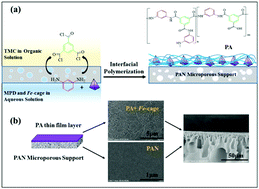当前位置:
X-MOL 学术
›
New J. Chem.
›
论文详情
Our official English website, www.x-mol.net, welcomes your feedback! (Note: you will need to create a separate account there.)
Porous metal–organic molecular cage: a promising candidate to highly improve the nanofiltration performance of thin film nanocomposite membranes†
New Journal of Chemistry ( IF 2.7 ) Pub Date : 2018-12-11 00:00:00 , DOI: 10.1039/c8nj04603d Chunfang Zhang 1, 2, 3, 4, 5 , Xuejian Si 1, 2, 3, 4, 5 , Shuo Zhang 1, 2, 3, 4, 5 , Bei Pei 1, 2, 3, 4, 5 , Jin Gu 1, 2, 3, 4, 5 , Yunxiang Bai 1, 2, 3, 4, 5
New Journal of Chemistry ( IF 2.7 ) Pub Date : 2018-12-11 00:00:00 , DOI: 10.1039/c8nj04603d Chunfang Zhang 1, 2, 3, 4, 5 , Xuejian Si 1, 2, 3, 4, 5 , Shuo Zhang 1, 2, 3, 4, 5 , Bei Pei 1, 2, 3, 4, 5 , Jin Gu 1, 2, 3, 4, 5 , Yunxiang Bai 1, 2, 3, 4, 5
Affiliation

|
Porous materials offer an attractive pathway to enhance the nanofiltration performance of thin film nanocomposite (TFN) membranes. Widely studied porous materials, such as zeolite, and metal–organic frameworks suffer from interfacial defects and poor dispersion in a polymer matrix, which leads to less than optimal performance of the TFN membranes. Porous metal–organic molecular cages are an exciting new family of porous materials that could ameliorate these issues by their better dispersing ability and intimate integration within the polymer matrix. By using the interfacial polymerization (IP) process, we synthesized a novel polyamide (PA) TFN membrane with highly improved nanofiltration performance using porous iron–organic molecular cage (Fe-cage) as the filler. Owing to the porous tetrahedral structure and polar –SO3Na group of the Fe-cage, the as-synthesized PA/Fe-cage TFN membranes at 1.0 wt% Fe-cage concentration in the aqueous solution showed water flux up to 26.33 L m−2 h−1, which was 3 times more than that of neat PA thin film composite (TFC) membranes, while simultaneously increasing the rejection ratio to 89.3% for Na2SO4 and 96% for Congo red. Further, the addition of Fe-cages induced a significant improvement in the antifouling property of the membranes, which could be attributed to both increased hydrophilicity and smooth surface microstructure of the membranes. These results provide a starting point for the high-performance TFN NF membranes by utilizing porous metal–organic molecular cages.
中文翻译:

多孔金属-有机分子笼:有望大大提高薄膜纳米复合膜的纳滤性能的†
多孔材料提供了一种有吸引力的途径来增强薄膜纳米复合材料(TFN)膜的纳滤性能。广泛研究的多孔材料(例如沸石)和金属有机骨架遭受界面缺陷和在聚合物基质中分散性差的困扰,这导致TFN膜的性能达不到最佳状态。多孔金属有机分子笼是令人兴奋的新型多孔材料家族,可以通过其更好的分散能力和在聚合物基质中的紧密结合来改善这些问题。通过使用界面聚合(IP)工艺,我们使用多孔的有机铁分子笼(Fe-cage)作为填料,合成了一种新型纳米过滤性能大大提高的聚酰胺(PA)TFN膜。由于多孔的四面体结构和极性–SO 3Fe笼中的Na组,合成的PA / Fe笼TFN膜在水溶液中的Fe笼浓度为1.0 wt%时显示出高达26.33 L m -2 h -1的水通量,是后者的3倍多与纯PA薄膜复合(TFC)膜相比,Na 2 SO 4的截留率提高到89.3 %,刚果红的截留率提高到96%。此外,铁笼的加入引起了膜的防污性能的显着改善,这可以归因于膜的亲水性增加和光滑的表面微观结构。这些结果为利用多孔金属有机分子笼的高性能TFN NF膜提供了起点。
更新日期:2018-12-11
中文翻译:

多孔金属-有机分子笼:有望大大提高薄膜纳米复合膜的纳滤性能的†
多孔材料提供了一种有吸引力的途径来增强薄膜纳米复合材料(TFN)膜的纳滤性能。广泛研究的多孔材料(例如沸石)和金属有机骨架遭受界面缺陷和在聚合物基质中分散性差的困扰,这导致TFN膜的性能达不到最佳状态。多孔金属有机分子笼是令人兴奋的新型多孔材料家族,可以通过其更好的分散能力和在聚合物基质中的紧密结合来改善这些问题。通过使用界面聚合(IP)工艺,我们使用多孔的有机铁分子笼(Fe-cage)作为填料,合成了一种新型纳米过滤性能大大提高的聚酰胺(PA)TFN膜。由于多孔的四面体结构和极性–SO 3Fe笼中的Na组,合成的PA / Fe笼TFN膜在水溶液中的Fe笼浓度为1.0 wt%时显示出高达26.33 L m -2 h -1的水通量,是后者的3倍多与纯PA薄膜复合(TFC)膜相比,Na 2 SO 4的截留率提高到89.3 %,刚果红的截留率提高到96%。此外,铁笼的加入引起了膜的防污性能的显着改善,这可以归因于膜的亲水性增加和光滑的表面微观结构。这些结果为利用多孔金属有机分子笼的高性能TFN NF膜提供了起点。
















































 京公网安备 11010802027423号
京公网安备 11010802027423号